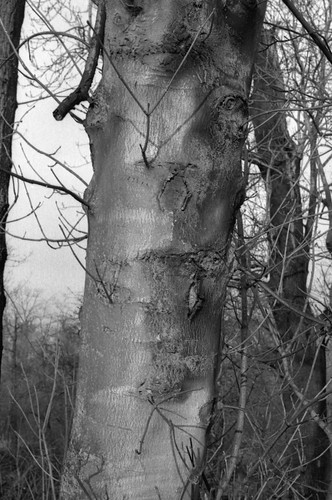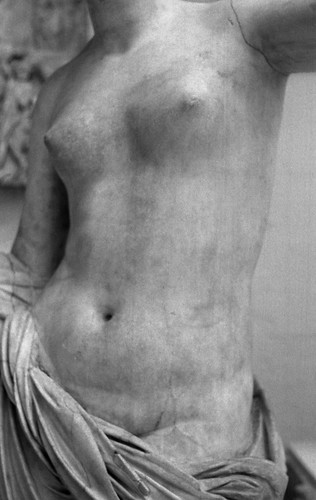Twenty years ago I received my first SLR camera, a secondhand
Praktica BC1, as a Christmas present. I'd had a Halina point-and-shoot camera for three or four years, which, although I used it avidly, provided fairly indifferent results. At the time, Prakticas were much cheaper than any other secondhand SLR cameras (I don't recall seeing Zenits around then) and the price differential was greater than it is now. What had provoked the desire for an SLR camera was, as a student at the time, a couple of months earlier I'd had a basic introduction to photography as part of my Foundation course in art and design.
For this introduction to photography, I shared a camera and a roll of film with four other students. I was first to have the camera and shot five full frames on the start of the roll of film. I did write notes in my sketchbook at the time, but did not make a note of either the camera used (a manual SLR, possibly a Pentax K1000) or the film (Fuji 400-PR in the rebate), or the developer (probably ID11). The photographs were shot during my lunchbreak before I handed the camera to the next student to use it. When thinking about writing this post, I couldn't remember the details of this introduction, but as I kept a diary at the time I've been able to look back at it. I had forgotten was that I was the demonstrator for the rest of the students: the photography technician had his arm in a sling, so I had to sit at the front of the class and demonstrate how to load film on a developing spiral, then load the film into a developing tank in the dark, and finally develop it while the technician explained the stages involved.
 |
| Sketchbook page, October 1993 |
I suspect the reason I was chosen to be the demonstrator that day was three years earlier, as part of GSCE Modular science, in a module on photography we shot and developed a roll of film with the basic darkroom we had at school. For the GCSE project, we used a rangefinder camera, and I particularly remember the rangefinder spot as a diamond, and that it seemed an arcane way to focus. I haven't been able to find the original negatives from 23 years ago, but I did later make a contact sheet (below), which shows that the film was Ilford HP5- before the 'Plus' version which was launched in 1989. I don't recall the results impressing me very much at the time, but it's possible that I retained enough of what we had done then to pick me out to demonstrate to the other students three years later.
 |
| GCSE Modular Science contact sheet from 1990 |
I kept my first prints from the Foundation course introduction in the sketchbook. From those precious five negatives, I printed three of them during the afternoon of the introduction, and below is the first print I made. I wrote in my diary that I was 'almost impressed' by my results and that I would 'definitely do more photography'.
 |
| Sketchbook page with my first print |
The first black and white film that I shot and developed with the Praktica BC1 (actually the second film through the camera, the first had been a colour film to document a college project set over the holiday) was also for a college project. We had been given an number of words to make work in response to, and two of these that I chose were 'form' and 'analysis'. For 'form' I took a number of photographs of torsos of Greek sculpture in the British Museum and contrasted these with the trunks of trees (new scans of the negatives below). 'Analysis' gave me an opportunity to take photographs of housing being demolished along the route of the M11 link road (now the A12), which I passed on the Central Line while travelling to college every day. I continued to take photographs along the route for the rest of my course, and have collected these together as the
M11 Link Road Archive.
 |
| Tree study, Praktica BC1 with Ilford HP5 Plus |
 |
| Torso, Praktica BC1 with Ilford HP5 Plus |
The Praktica BC1 didn't last very long: the shutter got stuck after four months, and it wasn't worth repairing (the camera cost £50, and I was quoted £60 to repair it), but I was able to buy a new body, a
BCA, for £26 and keep the original 50mm lens. I used the Praktica BCA all through my following degree course and afterwards, until I bought a
Canon A-1 when I first began to make some money from commissions and selling work a few years after leaving college.





No comments:
Post a Comment